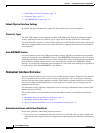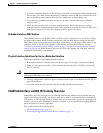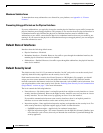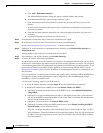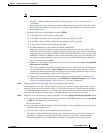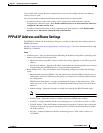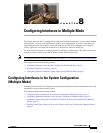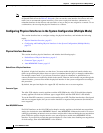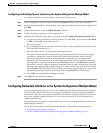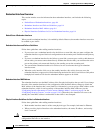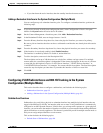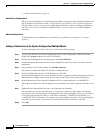
7-9
Cisco ASDM User Guide
OL-16647-01
Chapter 7 Configuring Interfaces in Single Mode
PPPoE IP Address and Route Settings
If you enable same security interface communication, you can still configure interfaces at different
security levels as usual.
You can also enable communication between hosts connected to the same interface.
• To enable interfaces on the same security level to communicate with each other, from the
Configuration > Interfaces pane, check Enable traffic between two or more interfaces which are
configured with same security level.
• To enable communication between hosts connected to the same interface, check Enable traffic
between two or more hosts connected to the same interface.
PPPoE IP Address and Route Settings
The PPPoE IP Address and Route Settings dialog lets you choose addressing and tracking options for
PPPoE connections.
See the “Configuring an Interface (Single Mode)” section on page 7-5 for more information about using
PPPoE for an interface.
Fields
• IP Address area—Lets you choose between Obtaining an IP address using PPP or specifying an IP
address, and contains the following fields:
–
Obtain IP Address using PPP—Select to enable the security appliance to use PPP to get an IP
address.
–
Specify an IP Address—Specify an IP address and mask for the security appliance to use instead
of negotiating with the PPPoE server to assign an address dynamically.
• Route Settings Area—Lets you configure route and tracking settings and contains the following
fields:
–
Obtain default route using PPPoE—Sets the default routes when the PPPoE client has not yet
established a connection. When using this option, you cannot have a statically defined route in
the configuration.
PPPoE learned route metric—Assigns an administrative distance to the learned route. Valid
values are from 1 to 255. If this field is left blank, the administrative distance for the learned
routes is 1.
–
Enable tracking—Check this checkbox to enable route tracking for PPPoE-learned routes.
Note Route tracking is only available in single, routed mode.
–
Primary Track—Select this option to configure the primary PPPoE route tracking.
–
Track ID—A unique identifier for the route tracking process. Valid values are from 1 to 500.
–
Track IP Address—Enter the IP address of the target being tracked. Typically, this would be the
IP address of the next hop gateway for the route, but it could be any network object available
off of that interface.
–
SLA ID—A unique identifier for the SLA monitoring process. Valid values are from 1 to
2147483647.




